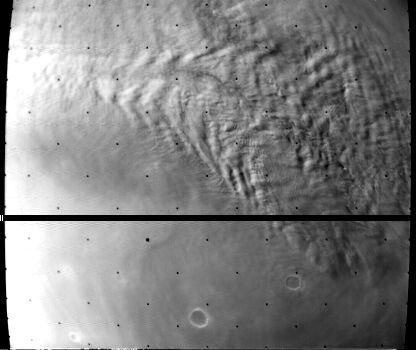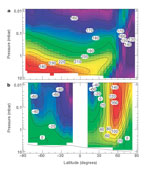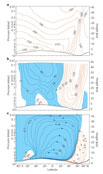Storm Evolution
Dust storms have been observed on the surface of Mars since the early
19th century when H. Flaugergues reported "yellowish clouds"
in 1809 (Zurek, 1992). Previous observers as early as the late
17th century such as Giacomo Filippo Maraldi had noted temporal variations
in the equatorial dark regions and the polar caps (Kieffer et al,
1992), and until modern times the light and dark regions were interpreted
as land and sea areas, with the temporal changes thought to be
seasonal variation in vegetation and polar ices (e.g.,
Percival Lowell
). While relatively regular observations of Mars have been made
since about 1901, it wasn't until 1956 that the first major global
storm was noted, and it was at this time that
Kuiper
(1957) suggested that the dark areas were lava fields and the
seasonal wave of darkening was due to the redistribution of dust (Zurek,
1992).
|
Mariner 9 Image of Dust Storm (click to enlarge)
|
In order to understand how this dust affects the atmosphere, it is critical to know the physical properties of the dust. Several studies (e.g., Toon et al, 1977; Wells et al, 1984) have undertaken this task, using orbiter and lander data to estimate dust parameters such as composition (igneous silicates, basalt, or their weathering products), particle size distributions (predominantly 1-10 microns), and sedimentation rates (~2x10 -3 g cm-2 yr -1) as well as optical properties .
|
MGS-TES vs. MGCM (click to enlarge)
|
|
One model aimed at simulating the evolution of a Martian dust storm by Murphy et al (1995) provides some insight into how dust and the atmosphere interact during a storm. Using a 3D version of a Martian GCM with simultaneously evolving thermal, dynamical, and radiatively active dust fields, they artificially induced a dust supply in a confined latitude zone in the southern subtropics, letting the model run for 40 days or more. Several phenomenon quite similar to that observed on Mars resulted:
- Hadley circulation and convection transported fine (~1 micron) dust up to 40 km altitude within a few days of storm onset, then spread it rapidly toward the poles and high elevations.
- Traveling and stationary eddies transported dust to mid and high northern (winter) latitudes.
- Northern (winter) hemisphere baroclinic waves weakened at onset, then intensified as the storm waned.
- Thermal tidal amplitude increased at the onset of the storm.
- Pressure response at Viking Lander 1 site agreed with observations.
Other links:
NASA-Ames Mars Atmospheric Modeling Group
NASA-Goddard GCM page
Atmospheric Optics Glossary
|
Evolution |
The Life Cycle of Martian Dust Storms
Planetary Atmospheres Final Project
by Than Putzig


